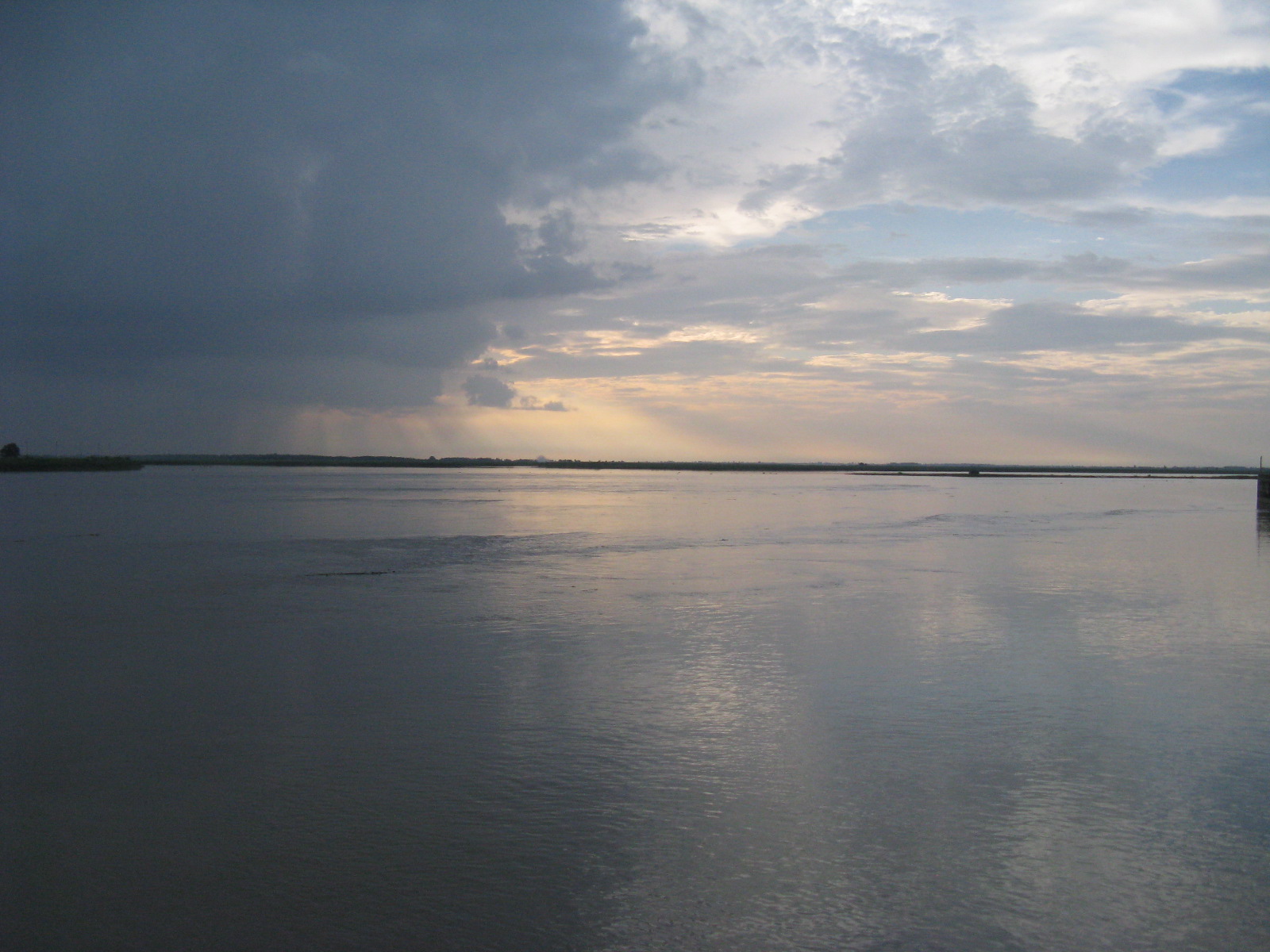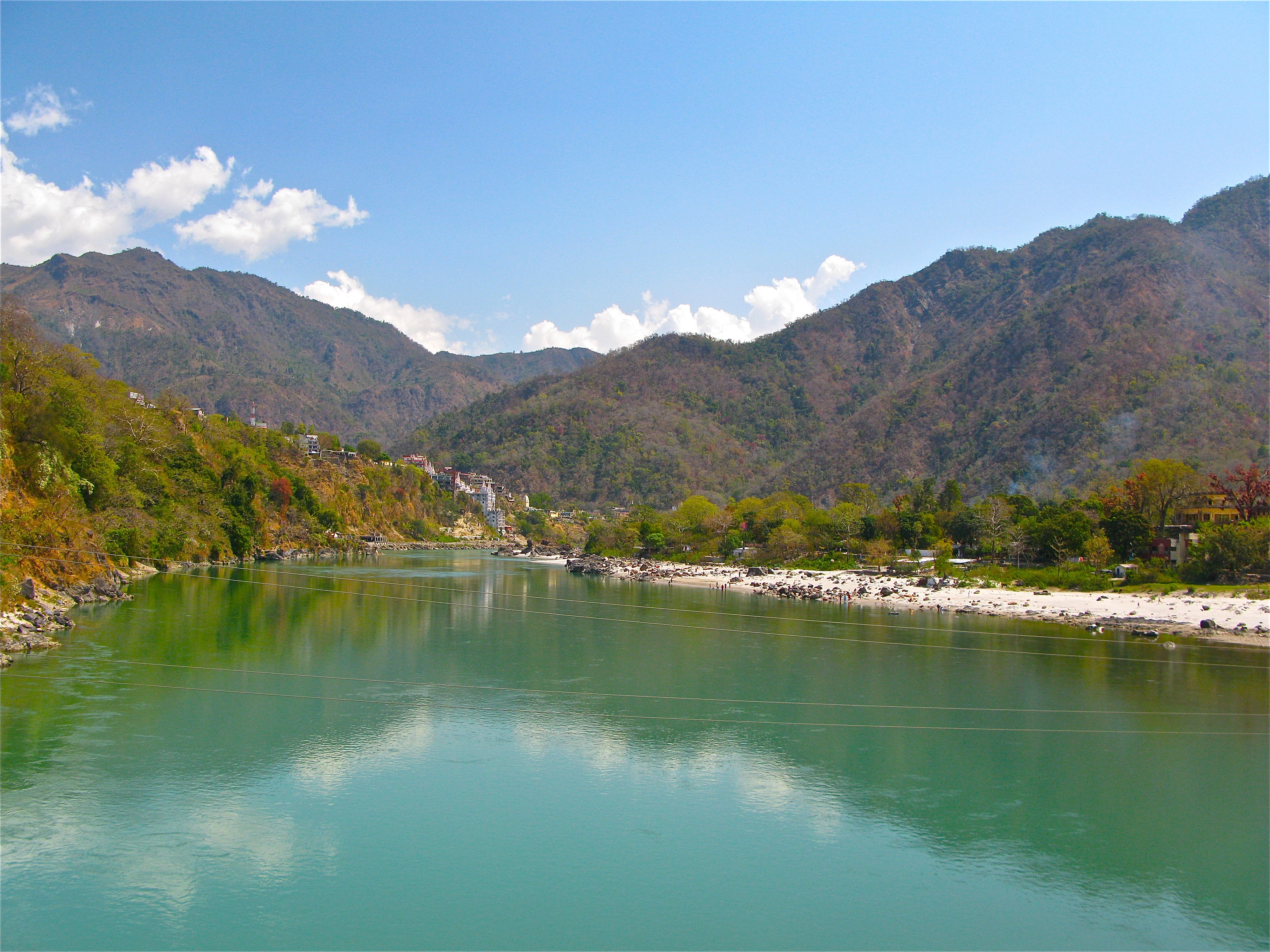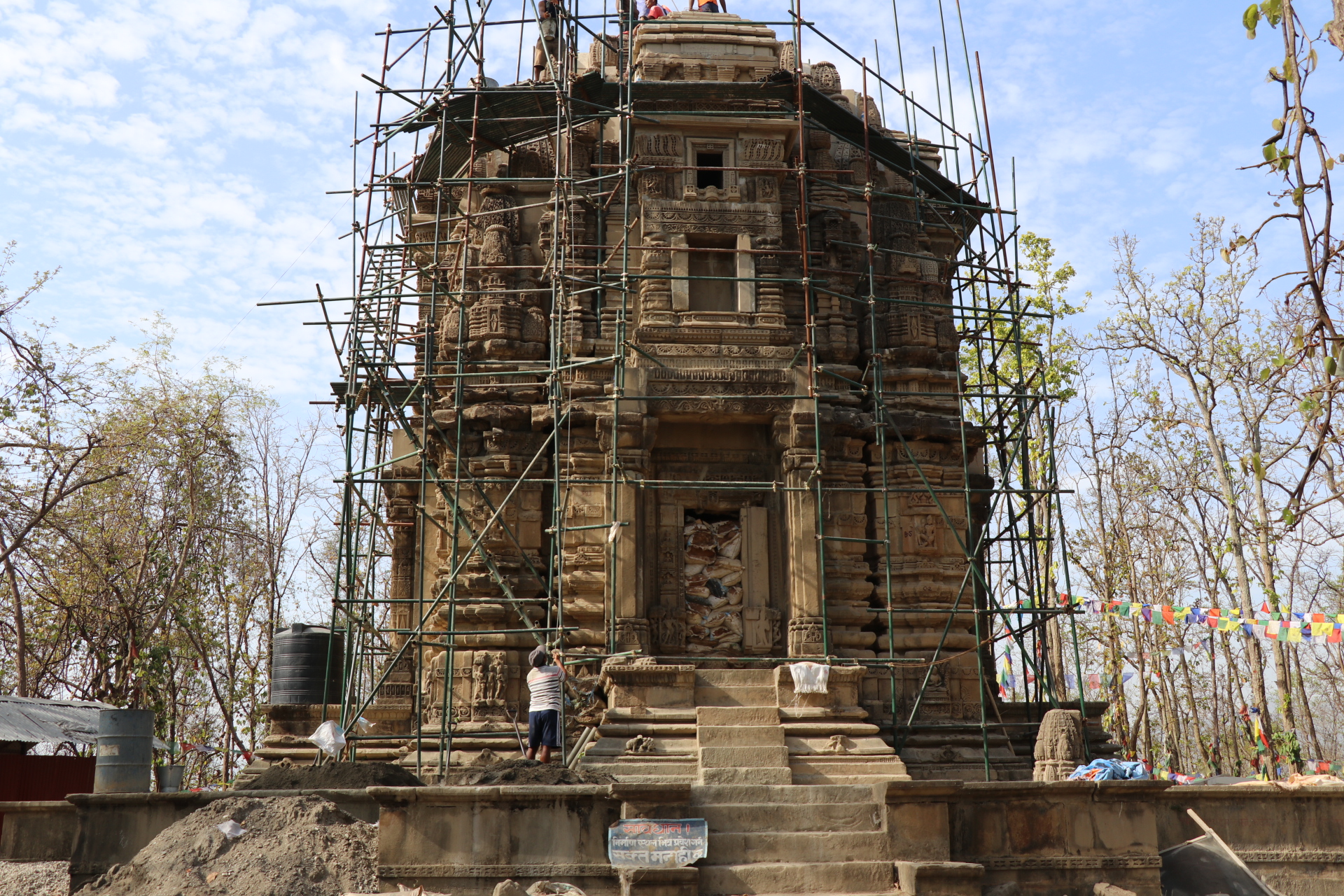|
Ghaghara River
Ghaghara, also called Karnali, is a perennial trans-boundary river originating on the Tibetan Plateau near Lake Manasarovar. The Karnali cuts through the Himalayas in Nepal and joins the Sharda River at Brahmaghat in India. Together they form the Ghaghara River, a major left bank tributary of the Ganges. With a length of it is the longest river in Nepal. The total length of Ghaghara River up to its confluence with the Ganges at Revelganj in Bihar is . It is the largest tributary of the Ganges by volume and the second longest tributary of the Ganges by length after Yamuna. Course The Ghaghara river rises in the southern slopes of the Himalayas in Tibet, in the glaciers of Mapchachungo, at an elevation of about above sea level. The river flows south through one of the most remote and least explored areas of Nepal as the Karnali River. The Seti River drains the western part of the catchment and joins the Karnali River in Doti District north of Dundras hill. Another ... [...More Info...] [...Related Items...] OR: [Wikipedia] [Google] [Baidu] |
Nepal
Nepal (; ne, नेपाल ), formerly the Federal Democratic Republic of Nepal ( ne, सङ्घीय लोकतान्त्रिक गणतन्त्र नेपाल ), is a landlocked country in South Asia. It is mainly situated in the Himalayas, but also includes parts of the Indo-Gangetic Plain, bordering the Tibet Autonomous Region of China to the north, and India in the south, east, and west, while it is narrowly separated from Bangladesh by the Siliguri Corridor, and from Bhutan by the Indian state of Sikkim. Nepal has a diverse geography, including fertile plains, subalpine forested hills, and eight of the world's ten tallest mountains, including Mount Everest, the highest point on Earth. Nepal is a multi-ethnic, multi-lingual, multi-religious and multi-cultural state, with Nepali as the official language. Kathmandu is the nation's capital and the largest city. The name "Nepal" is first recorded in texts from the Vedic period of the ... [...More Info...] [...Related Items...] OR: [Wikipedia] [Google] [Baidu] |
Sharda River
The Sharda River, also called Kali River and Mahakali River, originates at Kalapani in the Himalayas at an elevation of in the Pithoragarh district in Uttarakhand, India. It flows along Nepal's western border with India and has a basin area of . It joins Ghaghra River, a tributary of the Ganges. It takes the name Kali River from the union of the two streams at Gunji as it flows through the hills. After Brahmadev Mandi near Tanakpur, it enters the Terai plains, where it is called Sharda River. It offers potential for hydroelectric power generation. The river is also proposed as source for one of the many projects in the Himalayan component of the Indian Rivers Inter-link project. Etymology and naming It is named after Śāradā, which is another name for Saraswati, the goddess of learning. It is called Mahakali River in ne, महाकाली नदी, mahākālī nadī, , in Hindi, and Kali Gad (Kumaoni: काली गाड़, ''kālī gād'') or Kali Ga ... [...More Info...] [...Related Items...] OR: [Wikipedia] [Google] [Baidu] |
Siltstone
Siltstone, also known as aleurolite, is a clastic sedimentary rock that is composed mostly of silt. It is a form of mudrock with a low clay mineral content, which can be distinguished from shale by its lack of fissility.Blatt ''et al.'' 1980, pp.381-382 Although its permeability and porosity is relatively low, siltstone is sometimes a tight gas reservoir rock, an unconventional reservoir for natural gas that requires hydraulic fracturing for economic gas production. Siltstone was prized in ancient Egypt for manufacturing statuary and cosmetic palettes. The siltstone quarried at Wadi Hammamat was a hard, fine-grained siltstone that resisted flaking and was almost ideal for such uses. Description There is not complete agreement on the definition of siltstone. One definition is that siltstone is mudrock ( clastic sedimentary rock containing at least 50% clay and silt) in which at least 2/3 of the clay and silt fraction is composed of silt-sized particles. Silt is defi ... [...More Info...] [...Related Items...] OR: [Wikipedia] [Google] [Baidu] |
Chhapra
Chhapra is a city and headquarters of the Saran district in the Indian state of Bihar. It is situated near the junction of the Ghaghara River and the Ganges River. Chhapra grew in importance as a river-based market in the 18th century when the Dutch, French, Portuguese, and English established saltpeter refineries in the area. It was recognized as a municipality in 1864. The major railway station is Chhapra junction. There is a well known shakti peeth temple in Chhapra named Ambika Bhavani. Geography Chhapra is located at . It has an average elevation of . India's biggest double-decker flyover is being constructed in Chhapra. This 3.5 km long double-decker flyover from Bhikhari Chowk to Bus Stand, is being constructed at the cost of 411.31 crore from the central road fund (CRF) under engineering procurement construction (EPC) mode by Bihar Rajya Pul Nirman Nigam Limited (BRPNNL). It is longer than 1.8 km double-decker flyover in Santa Cruz–Chembur Link Ro ... [...More Info...] [...Related Items...] OR: [Wikipedia] [Google] [Baidu] |
Uttar Pradesh
Uttar Pradesh (; , 'Northern Province') is a state in northern India. With over 200 million inhabitants, it is the most populated state in India as well as the most populous country subdivision in the world. It was established in 1950 after India had become a republic. It was a successor to the United Provinces (UP) during the period of the Dominion of India (1947–1950), which in turn was a successor to the United Provinces (UP) established in 1935, and eventually of the United Provinces of Agra and Oudh established in 1902 during the British Raj. The state is divided into 18 divisions and 75 districts, with the state capital being Lucknow, and Prayagraj serving as the judicial capital. On 9 November 2000, a new state, Uttaranchal (now Uttarakhand), was created from Uttar Pradesh's western Himalayan hill region. The two major rivers of the state, the Ganges and its tributary Yamuna, meet at the Triveni Sangam in Prayagraj, a Hindu pilgrimage site. O ... [...More Info...] [...Related Items...] OR: [Wikipedia] [Google] [Baidu] |
Mahakali River
The Sharda River, also called Kali River and Mahakali River, originates at Kalapani in the Himalayas at an elevation of in the Pithoragarh district in Uttarakhand, India. It flows along Nepal's western border with India and has a basin area of . It joins Ghaghra River, a tributary of the Ganges. It takes the name Kali River from the union of the two streams at Gunji as it flows through the hills. After Brahmadev Mandi near Tanakpur, it enters the Terai plains, where it is called Sharda River. It offers potential for hydroelectric power generation. The river is also proposed as source for one of the many projects in the Himalayan component of the Indian Rivers Inter-link project. Etymology and naming It is named after Śāradā, which is another name for Saraswati, the goddess of learning. It is called Mahakali River in ne, महाकाली नदी, mahākālī nadī, , in Hindi, and Kali Gad (Kumaoni: काली गाड़, ''kālī gād'') or Kali Ganga ... [...More Info...] [...Related Items...] OR: [Wikipedia] [Google] [Baidu] |
Siwalik Hills
The Sivalik Hills, also known as the Shivalik Hills and Churia Hills, are a mountain range of the outer Himalayas that stretches over about from the Indus River eastwards close to the Brahmaputra River, spanning the northern parts of the Indian subcontinent. It is wide with an average elevation of . Between the Teesta and Raidāk Rivers in Assam is a gap of about . "Sivalik" literally means 'tresses of Shiva'. Sivalik region is home to the Soanian archaeological culture. Geology Geologically, the Sivalik Hills belong to the Tertiary deposits of the outer Himalayas. They are chiefly composed of sandstone and conglomerate rock formations, which are the solidified detritus of the Himalayas to their north; they are poorly consolidated. The remnant magnetisation of siltstones and sandstones indicates that they were deposited 16–5.2 million years ago. In Nepal, the Karnali River exposes the oldest part of the Shivalik Hills. They are bounded on the south by a fault sy ... [...More Info...] [...Related Items...] OR: [Wikipedia] [Google] [Baidu] |
Surkhet
Surkhet District ( ne, सुर्खेत जिल्ला, ) is a district in Karnali Province of mid-western Nepal. Surkhet is the one of the ten districts of Karnali located about west of the national capital Kathmandu. The district's area is . It had 288,527 population in 2001 and 350,804 in 2011 which male comprised 169,461 and female 181,381. Its district headquarters, Birendranagar, is the capital of Karnali Province. It is serving as a business hub and document center for Karnali province. According to population, development, road links, landforms, climate, many peoples are migrating here. after becoming province capital developmental activities are boosted and are in peak level. all the governmental works are carried here. Birendranagar is beautiful valley surrounded by hills having moderate climate. Geography and Climate Surkhet Valley is one of the Inner Terai Valleys of Nepal. It borders, Achham district of Sudurpashchim, Dailekh and Jajarkot districts to the nor ... [...More Info...] [...Related Items...] OR: [Wikipedia] [Google] [Baidu] |
Dhaulagiri
Dhaulagiri is the seventh highest mountain in the world at above sea level, and the highest mountain within the borders of a single country (Nepal). It was first climbed on 13 May 1960 by a Swiss-Austrian-Nepali expedition. Annapurna I () is east of Dhaulagiri. The Kali Gandaki River flows between the two in the Kaligandaki Gorge, said to be the world's deepest. The town of Pokhara is south of the Annapurnas, an important regional center and the gateway for climbers and trekkers visiting both ranges as well as a tourist destination in its own right. Toponymy Dhaulagiri (धौलागिरी) is the Nepali name for the mountain which comes from Sanskrit where धवल (dhawala) means dazzling, white, beautiful and गिरि (giri) means mountain. Dhaulagiri I is also the highest point of the Gandaki river basin. Geography Looking north from the plains of India, most 8,000-metre peaks are obscured by nearer mountains, but in clear weather, Dhaulagiri is conspicu ... [...More Info...] [...Related Items...] OR: [Wikipedia] [Google] [Baidu] |
Doti District
Doti District ( ne, डोटी जिल्ला ), part of Sudurpashchim Province, is one of the 77 districts of Nepal. This district, with Silgadhi as its headquarters, covers an area of with a population of 207,066 in 2001 and increasing marginally to 211,746 in 2011. History Doti was a medieval kingdom of Kumaon. It was founded by Niranjan Malla Dev, the last son of the Katyuri dynasty and younger brother of Abhay Pal of Askot. Previously, the area between Ramganga in the west and the Karnali River in the east was under the control of the Raikas (rulers of the Doti kingdom, alternately Kumaun or ''Rainka Maharaj''). Ancient Doti was a part of Kumaon Kingdom, Now remaining Kumaon region is part of Uttrakhand a state in modern-day india, Nepal's neighboring country. Kingdom of Kumaon lost Doti during the expansion of Nepal Kingdom in 1790. It was formed after the Katyuri Kingdom's disintegration during the 13th century. Doti was one of eight different princ ... [...More Info...] [...Related Items...] OR: [Wikipedia] [Google] [Baidu] |
Tibet
Tibet (; ''Böd''; ) is a region in East Asia, covering much of the Tibetan Plateau and spanning about . It is the traditional homeland of the Tibetan people. Also resident on the plateau are some other ethnic groups such as Monpa people, Monpa, Tamang people, Tamang, Qiang people, Qiang, Sherpa people, Sherpa and Lhoba peoples and now also considerable numbers of Han Chinese and Hui people, Hui settlers. Since Annexation of Tibet by the People's Republic of China, 1951, the entire plateau has been under the administration of the People's Republic of China, a major portion in the Tibet Autonomous Region, and other portions in the Qinghai and Sichuan provinces. Tibet is the highest region on Earth, with an average elevation of . Located in the Himalayas, the highest elevation in Tibet is Mount Everest, Earth's highest mountain, rising 8,848.86 m (29,032 ft) above sea level. The Tibetan Empire emerged in the 7th century. At its height in the 9th century, the Tibet ... [...More Info...] [...Related Items...] OR: [Wikipedia] [Google] [Baidu] |
Mansarovar
Lake Manasarovar (Sanskrit: मानसरोवर), also called Mapam Yutso (;) locally, is a high altitude freshwater lake fed by the Kailash Glaciers near Mount Kailash in Burang County, Ngari Prefecture, Tibet Autonomous Region, China. The lake along with Mount Kailash to its north are sacred sites in four religions: Bön, Buddhism, Hinduism and Jainism. Etymology The Sanskrit word "''Manasarovar''" (मानसरोवर) is a combination of two Sanskrit words; "''Mānas''" (मानस्) meaning "mind (in its widest sense as applied to all the mental powers), intellect, intelligence, understanding, perception, sense, conscience''" while "''sarovara''" (सरोवर) means "''a lake or a large pond deep enough for a lotus''". Geography It is located about 50 kilometers to the northwest of Nepal, about 100 kilometers east of Uttarakhand, and in the southwest region of Tibet. The lake lies at above mean sea level, a relatively high elevation for a large f ... [...More Info...] [...Related Items...] OR: [Wikipedia] [Google] [Baidu] |







